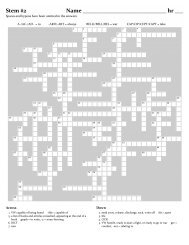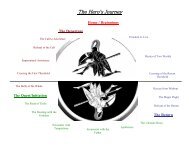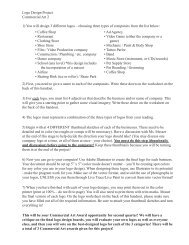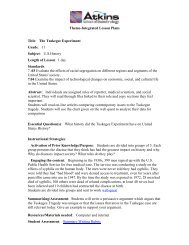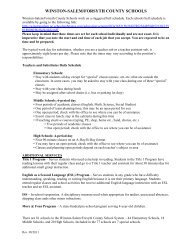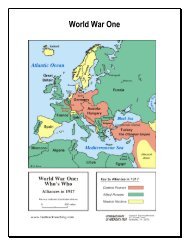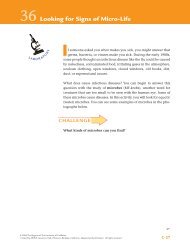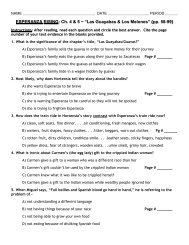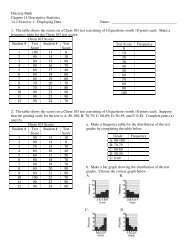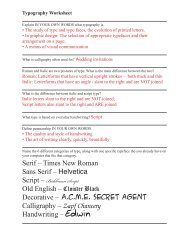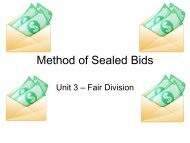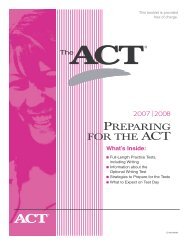An EGG-CELLent Lab Activity
An EGG-CELLent Lab Activity
An EGG-CELLent Lab Activity
You also want an ePaper? Increase the reach of your titles
YUMPU automatically turns print PDFs into web optimized ePapers that Google loves.
<strong>An</strong> <strong>EGG</strong>-<strong>CELLent</strong> <strong>Lab</strong> <strong>Activity</strong><br />
OSMOSIS OSMOSIS & DIFFUSION DIFFUSION <strong>EGG</strong> <strong>EGG</strong> LAB LAB<br />
LAB LAB ACTIVITY ACTIVITY QUESTIONS<br />
QUESTIONS<br />
NAME:<br />
1. BEFORE YOU DO ANYTHING ELSE! Carefully drain the vinegar from your cell<br />
cup and cover the cell with cold tap water. You must allow this to set while<br />
you complete this page.<br />
2. BEFORE YOU MAY MOVE ON - Write the BEST definition for the<br />
following words.<br />
YOU MUST COMPLETE THIS SECTION BEFORE YOU ARE ALLOWED<br />
TO MOVE ON! WHEN YOU COMPLETE THIS PAGE, COME TO THE<br />
FRONT TO RECEIVE YOUR STAMP TO MOVE ON.<br />
Diffusion<br />
Hypotonic Solution<br />
Osmosis<br />
Hypertonic Solution<br />
Selective Permeability<br />
Facilitated Diffusion<br />
Plasma Membrane<br />
Active Transport<br />
Membrane Protein<br />
Passive Transport<br />
Isotonic Solution<br />
Concentration Gradient
3. Next, you must collect some data on your cell. Carefully remove your egg from the<br />
water and gently rinse it then dry it.<br />
4. Complete the data table below with the observations you make about your cell and<br />
the cell of FIVE other students in the class.<br />
NOTE – YOU MUST COLLECT DATA FROM A TOTAL OF SIX CELLS. YOUR CELL<br />
WILL BE ONE OF THESE! YOUR DATA MUST INCLUDE:<br />
TWO “#1 STUDENTS”, TWO “#2” STUDENTS, AND TWO “#3” STUDENTS<br />
STUDENT’S NAME NUMBER<br />
GIVEN TO<br />
STUDENT<br />
1. 1<br />
BEFORE<br />
QUANTITATIVE<br />
ORIGINAL<br />
WEIGHT<br />
QUANTITATIVE<br />
ORIGINAL<br />
WIDTH<br />
QUALITATIVE<br />
VISUAL<br />
OBSERVATIONS<br />
2. 1<br />
3. 2<br />
4. 2<br />
5. 3<br />
6. 3<br />
5. Return your cell to the cup. Based on the number you were given at the beginning of<br />
class, you will put your cell in one of the following solutions:<br />
#1 students will cover their cells with Maple Syrup<br />
#2 students will cover their cells with Salt Water<br />
#3 students will cover their cells with plain tap water<br />
6. Based on your knowledge of the plasma membrane and osmosis, make a prediction<br />
about the behavior of each of the cells after it has spent several days in the solution:<br />
Cells placed into the Maple Syrup will:<br />
Because:<br />
Cells placed into the Salt Water will:<br />
Because:<br />
Cells placed into the Tap Water will:<br />
Because:
7. After your cell has spent several days in solution, carefully remove it from the<br />
solution, rinse it off, and dry it. Repeat the observations from step 4.<br />
AFTER<br />
STUDENT’S NAME<br />
NUMBER<br />
GIVEN TO<br />
STUDENT<br />
1. 1<br />
2. 1<br />
3. 2<br />
4. 2<br />
5. 3<br />
6. 3<br />
QUANTITATIVE<br />
FINAL<br />
WEIGHT<br />
QUANTITATIVE<br />
FINAL<br />
WIDTH<br />
QUALITATIVE<br />
FINAL VISUAL<br />
OBSERVATIONS<br />
8. What observations can you make about the eggs that were placed into the syrup<br />
What changes have happened from the beginning<br />
9. Based on these observations, what type of solution would be the BEST description for<br />
the syrup<br />
10. Explain why you believe syrup is the type of solution you selected. Give details<br />
about how your observations support your explanation and the definition of that<br />
solution.
11. What observations can you make about the eggs that were placed into the salt<br />
water What changes have occurred<br />
12. Based on your observations, what type of solution would be the BEST description<br />
for the salt water<br />
13. Explain why you believe salt water is the type of solution you selected. Give details<br />
about how your observations support your explanation and the definition of that<br />
solution.<br />
14. Based on your observations, what type of solution would be the BEST description<br />
for the plain tap water<br />
15. Explain why you believe plain tap water is the type of solution you selected. Give<br />
details about how your observations support your explanation and the definition of<br />
that solution.



